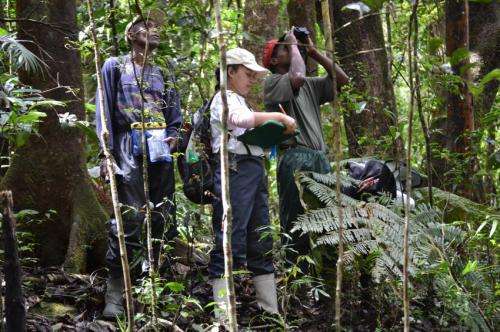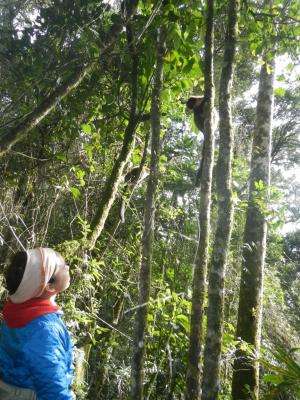Gardeners of Madagascar rainforest at risk

A majority of Madagascar's 101 species of lemurs are threatened with extinction, and that could have serious consequences for the rainforests they call home. A new study by Rice University researchers shows the positive impacts lemurs can have on rainforest tree populations, which raises concerns about the potential impact their disappearance could have on the region's rich biodiversity.
A large proportion of trees in Madagascar's rainforest have fruits eaten by lemurs. Lemurs in turn disperse the seeds of their fruit trees throughout the forest with their scat. Such dispersal can play a crucial role for a tree species' ability to regenerate, but effects are poorly understood, especially when there are multiple dispersers.
For the tree, the evolutionary advantage of having animal-dispersed seeds may be that the seeds land well away from their parent trees where survival is low or that seeds are directed into spots where they are the most likely to sprout and survive.
Amy Dunham, an assistant professor of biosciences, and graduate student Onja Razafindratsima set out to detail the symbiotic relationship between fruit-eating lemurs and the trees that feed them through a three-year study in a rainforest in southeastern Madagascar.
Their data from observations, experiments and mathematical models demonstrate that seeds of a common canopy tree have a 300 percent higher chance of sprouting and becoming a sapling when dispersed by lemurs versus simply falling to the ground. One of the three lemur species is particularly good at dropping seeds in spots that are most advantageous for sprouting and survival. Other lemurs are not so selective, but still benefit the tree by moving seeds away from the parent tree. By acting as forest gardeners, these animals give the tree's population a boost.
The study appeared online in the Ecological Society of America journal Ecology.
As part of the study, the researchers followed the seed-dispersal patterns of three of Madagascar's lemur species: the red-fronted brown lemur, the red-bellied lemur and the southern black-and-white ruffed lemur. That meant tracking and observing groups of lemurs as the animals leaped from tree to tree through the forest, dined in the 65-foot-high canopies and dropped their undigested seeds at ground level.
Razafindratsima led the study as part of a thesis project she expects to complete early next year. She built a team of local researchers near Ranomafana National Park, the home of Centre ValBio, a research station founded by Dunham's former Ph.D. adviser, primatologist Patricia Wright.
"We have a team of up to 10 local villagers who are trained to do research," said Razafindratsima, a native of Madagascar. "Their exceptional knowledge of the forest is very important to us when we're trying to track lemurs and identify seeds and seedlings in a forest with over 300 species of trees."
The research team tracked 24 groups of lemurs over a year without the benefit of radio collars, said Razafindratsima, who keeps in touch with her team via phone and Skype when she's at Rice. She said the study sites were as close as a short hike from Centre ValBio and as far as a two-day trek through steep terrain that entailed camping overnight.

In addition to tracking lemurs and their dispersed seeds, the research team spent three years carrying out experiments on seed sprouting and survival. They found that dispersal by lemurs dramatically increased the odds that seeds would take root and survive. In particular, the red-fronted brown lemurs tended to drop seeds away from their parent trees and in places where there were gaps in the canopy. This gave individual seeds the best shot at taking root.
Dunham said trees benefit from the wide dispersal of their seeds, and for some species in Madagascar, lemurs are the primary or only animal that can distribute those seeds. As the largest fruit-eaters in the system, these lemurs swallow seeds that may be too large for other fruit-eating animals, such as birds or bats.
"Seeds away from the parent tree survive better because there's less competition among seedlings," Razafindratsima said. "If they're close by the parent, they may also share the same natural enemies, like soil pathogens and seed predators, so there's higher mortality."
Trees that lose their dispersers will simply drop their seeds to the ground beneath their canopies, where chances of survival are slim, Dunham said. "Lemurs fill an important role as the gardeners for these trees. By ensuring that some seeds land in spots suitable for germination and survival, they increase the ability of these trees to replace themselves"
Dunham hopes the study will contribute to growing efforts to protect lemurs, and therefore the rainforest, which has been impacted in recent years by economic and political instability. She noted grassroots efforts within Madagascar led to the first World Lemur Festival in late October to celebrate and protect the animals and their habitats in Madagascar.
"What got us interested is that frugivorous lemur populations are declining across the island, and we know very little about how these seed dispersers actually affect tree populations," she said. "Once we understand that better, maybe we'll have a better idea of how the community might change if the lemurs disappear.
"If some species suddenly lose their dispersers, but others dispersed by birds or the wind are doing fine, it may change population trajectories and alter which tree species are dominant in a community. To understand what happens when these species are lost, we need to understand their role in the ecosystem," she said.
More information: Ecology, www.esajournals.org/doi/abs/10.1890/14-0684.1
Journal information: Ecology
Provided by Rice University




















